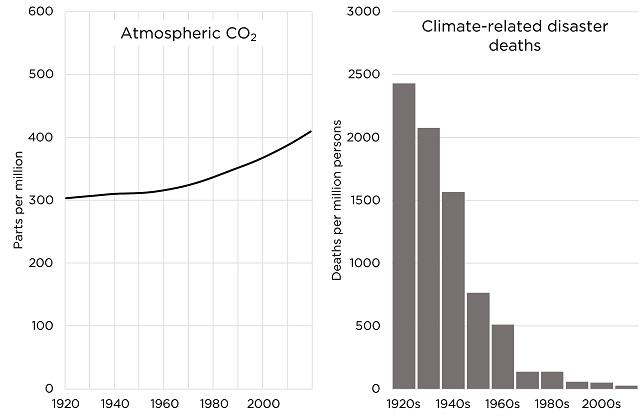Economy
Climate researchers show we’re actually “safer than ever from climate” catastrophes

The climate safety denial movement
I and others have documented that we’re safer than ever from climate. Catastrophists can’t refute us, so they’re now saying that disaster deaths don’t matter!
|
|
For decades climate catastrophists have portrayed climate disasters as getting deadlier and deadlier.
Now that I and others have documented that we’re safer than ever from climate, catastrophists are saying that disaster deaths don’t matter!
- Reuters says “Drop in climate-related disaster deaths not evidence against climate emergency.”
But a drop in deaths from something—here, a 98% drop—is obvious evidence against it being an emergency.
Would Reuters say: “98% drop in flu deaths not evidence against flu emergency”?¹
- Why is Reuters, along with The New York Times, PolitiFact, and USA Today, claiming that a 98% drop in climate disaster deaths doesn’t contradict their climate emergency narrative? Because it obviously does, and they can only save their narrative by intimidating us into denying the obvious.²
- The central narrative of climate catastrophists is that fossil fuels and their CO2 emissions are killing more and more people via climate disasters.
This narrative has always had a fatal weakness: it totally contradicts the data, which show plummeting climate disaster deaths.³
- Why are climate disaster deaths plummeting as fossil fuel use and CO2 emissions rise?
Because the enormous ability uniquely cost-effective and scalable fossil fuel energy gives us to master climate danger far outweighs any new climate challenges from CO2 emissions.
- An example of fossil-fueled climate mastery overwhelming CO2 impacts is drought.
Any contribution of rising CO2 to drought has been overwhelmed by fossil-fueled irrigation and crop transport, which have helped reduce drought deaths by over 100 times over 100 years as CO2 levels have risen.⁴
- Over the last decade, I and a number of others, including Bjorn Lomborg and Michael Shellenberger, have challenged catastrophism by pointing to declining climate disaster deaths.
Catastrophists couldn’t refute our argument. So instead they pretended it didn’t exist.
Until last year.⁵
- In 2023, climate catastrophists finally felt compelled to address the fact that climate disaster deaths have plummeted (driven by fossil-fueled climate mastery).
Because of honesty? No—because Presidential candidates started bringing it up and persuading people with it.
- Here is Vivek Ramaswamy during his Presidential campaign referring to a 98% decline in climate disaster deaths—and, crucially, giving fossil fuel energy credit.
- Here is Ron DeSantis during his Presidential campaign referring to a 98% decline in climate disaster deaths—and, crucially, giving fossil fuel energy credit.
- The 98% decline in climate disaster deaths, driven by fossil fuels, is a blockbuster fact: it shows that we are experiencing not fossil-fueled climate emergency but fossil-fueled climate safety.
But instead of being happy, catastrophists engage in climate safety denial.
- Here are 3 recent instances of climate safety denial—from Reuters, PolitiFact, and USA Today. All have long portrayed climate deaths as a fast-increasing problem. But now they claim deaths don’t matter.
https://www.reuters.com/fact-check/drop-climate-related- disaster-deaths-not-evidence- against-climate-emergency- 2023-09-19/ - Climate safety denial utilizes 5 main myths to evade the decline in disaster deaths:
1. Fossil fuels don’t deserve credit
2. Weather forecasting deserves the credit
3. 100 years is a misleading period
4. Damages are drastically increasing
5. There’s a major increase in reported disasters - Myth 1: Fossil fuels don’t deserve much credit for plummeting climate disaster deaths; it’s “resilience.”
Truth: Uniquely cost-effective and scalable fossil fuel energy makes us resilient through plentiful infrastructure-building, heating and cooling, irrigation, transportation, etc.⁶
- Myth 2: Storm warning systems deserve the credit for plummeting climate disaster deaths.
Truth: Drought, not storm, deaths are the leading source of reduced climate deaths. And fossil fuels power storm warning and evacuation systems (and more resilient infrastructure).⁷
- Myth 3: 100 years is a misleading period to measure plummeting climate disaster deaths.
Truth: 100 years is a standard, very meaningful period to look at. While we have data going back an additional two decades, those tend to underreport due to less global communication.⁸
- Contrary to the claim that starting analysis of climate disaster deaths in the 1920s overestimates the decline, it actually likely underestimates the decline due to insufficient past reporting; data before WWII extremely likely underreport deaths compared to data after 2000.
- Myth 4: There is an alarming increase in reported disasters, revealing an underlying climate emergency.
Truth: The increase in reported disasters over time is due overwhelmingly to increased global communication. Changes in fundamentals, such as storms, are extremely modest.⁹
- The claim that more reported disasters show an increasingly dangerous climate is absurd in light of the fact that underlying data show massive increases in reporting before significant human climate impacts and the reporting trend also massively goes up for non-climate causes!
- Other biases might inflate the number of reported disasters. E.g., governments of poor countries have an incentive to declare more disasters with increasing international relief.¹⁰
- Using obviously problematic disaster frequency reporting instead of direct climatological evidence to try and show increasing climate danger is a revealing choice by catastrophists. They are making it because the climate change we’ve experienced has been very modest—and masterable.
Do Not Declare a “Climate Emergency”
·AUGUST 17, 2023Read full story - An example of unalarming climate fundamentals: neither the frequency nor the energy in global hurricanes has changed significantly relative to the noisy average. There is also little evidence for more landfalling hurricanes.¹¹
- The catastrophist attempt to undermine the 98% decrease in disaster deaths by pointing to the increased reporting of disasters is actually self-defeating.
If disaster deaths are plummeting despite incomplete past reporting, that means they’ve declined by even more than 98%.
- Myth 5: Climate damages are drastically increasing, revealing an underlying climate emergency.
Truth: Even though there are many incentives for climate damages to go up—preferences for riskier areas, government bailouts—GDP-adjusted damages are flat.¹²
- We often hear that “billion-dollar disasters” have increased significantly. But this is a bogus metric. Of course, as GDP grows we’ll have more billion-dollar disasters because there is more wealth for disasters to strike. But when we adjust for GDP there’s no increase in damage.¹³
- A Reuters “fact check” alarmingly claims a 151% growth in disaster damages from a period starting in 1978 to a period ending in 2017.
But they evade that the global economy grew by over 200% during that period!
(And they evade that disaster and damage reporting increased.)¹⁴
- The stupidest climate safety denial myth (used by The New York Times): 2 million people died from extreme weather in the last 50 years; that’s obviously an emergency.
Truth: 2 million in 50 years is a rate of 40,000 per year—far, far less than 100 years ago, thus confirming today’s climate safety.¹⁵
- The last-gasp climate safety denial myth: Okay, we’re safer than ever from climate disasters, and it is driven by cheap energy from fossil fuels, but we can easily replace fossil fuels with solar and wind.
Truth: For the foreseeable future there is no cheap global energy without fossil fuels.
The ultimate debunking of “solar and wind are cheaper than fossil fuels.”
·JULY 19, 2023Read full story - Observe that all these seemingly scientific outlets, such as The New York Times, Reuters, and PolitiFact are totally unable to refute the death-blow to their “climate emergency” narrative that is the drastic decline in climate disaster deaths.
Science requires that they admit defeat.
Popular links
- EnergyTalkingPoints.com: Hundreds of concise, powerful, well-referenced talking points on energy, environmental, and climate issues.
- My new book Fossil Future: Why Global Human Flourishing Requires More Oil, Coal, and Natural Gas—Not Less.
- Speaking and media inquiries.
“Energy Talking Points by Alex Epstein” is my free Substack newsletter designed to give as many people as possible access to concise, powerful, well-referenced talking points on the latest energy, environmental, and climate issues from a pro-human, pro-energy perspective.
Share Energy Talking Points by Alex Epstein
UC San Diego – The Keeling Curve
For every million people on earth, annual deaths from climate-related causes (extreme temperature, drought, flood, storms, wildfires) declined 98%–from an average of 247 per year during the 1920s to 2.5 per year during the 2010s.
Data on disaster deaths come from EM-DAT, CRED / UCLouvain, Brussels, Belgium – www.emdat.be (D. Guha-Sapir).
Population estimates for the 1920s from the Maddison Database 2010, the Groningen Growth and Development Centre, Faculty of Economics and Business at University of Groningen. For years not shown, population is assumed to have grown at a steady rate.
Population estimates for the 2010s come from World Bank Data
Business
Your $350 Grocery Question: Gouging or Economics?

Dr. Sylvain Charlebois, a visiting scholar at McGill University and perhaps better known as the Food Professor, has lamented a strange and growing trend among Canadians. It seems that large numbers of especially younger people would prefer a world where grocery chains and food producers operated as non-profits and, ideally, were owned by governments.
Sure, some of them have probably heard stories about the empty shelves and rationing in Soviet-era food stores. But that’s just because “real” communism has never been tried.
In a slightly different context, University of Toronto Professor Joseph Heath recently responded to an adjacent (and popular) belief that there’s no reason we can’t grow all our food in publicly-owned farms right on our city streets and parks:
“Unfortunately, they do have answers, and anyone who stops to think for a minute will know what they are. It’s not difficult to calculate the amount of agricultural land that is required to support the population of a large urban area (such as Tokyo, where Saitō lives). All of the farms in Japan combined produce only enough food to sustain 38% of the Japanese population. This is all so obvious that it feels stupid even to be pointing it out.”
Sure, food prices have been rising. Here’s a screenshot from Statistics Canada’s Consumer Price Index price trends page. As you can see, the 12-month percentage change of the food component of the CPI is currently at 3.4 percent. That’s kind of inseparable from inflation.

But it’s just possible that there’s more going on here than greedy corporate price gouging.
It should be obvious that grocery retailers are subject to volatile supply chain costs. According to Statistics Canada, as of June 2025, for example, the price of “livestock and animal products” had increased by 130 percent over their 2007 prices. And “crops” saw a 67 percent increase over that same period. Grocers also have to lay out for higher packaging material costs that include an extra 35 percent (since 2021) for “foam products for packaging” and 78 percent more for “paperboard containers”.
In the years since 2012, farmers themselves had to deal with 49 percent growth in “commercial seed and plant” prices, 46 percent increases in the cost of production insurance, and a near-tripling of the cost of live cattle.
So should we conclude that Big Grocery is basically an industry whose profits are held to a barely sustainable minimum by macro economic events far beyond their control? Well that’s pretty much what the Retail Council of Canada (RCC) claims. Back in 2023, Competition Bureau Canada published a lengthy response from the RCC to the consultation on the Market study of retail grocery.
The piece made a compelling argument that food sales deliver razor-thin profit margins which are balanced by the sale of more lucrative non-food products like cosmetics.
However, things may not be quite as simple as the RCC presents them. For instance:
- While it’s true that the large number of supermarket chains in Canada suggests there’s little concentration in the sector, the fact is that most independents buy their stock as wholesale from the largest companies.
- The report pointed to Costco and Walmart as proof that new competitors can easily enter the market, but those decades-old well-financed expansions prove little about the way the modern market works. And online grocery shopping in Canada is still far from established.
- Consolidated reporting methods would make it hard to substantiate some of the report’s claims of ultra-thin profit margins on food.
- The fact that grocers are passing on costs selectively through promotional strategies, private-label pricing, and shrinkflation adjustments suggests that they retain at least some control over their supplier costs.
- The claim that Canada’s food price inflation is more or less the same as in other peer countries was true in 2022. But we’ve since seen higher inflation here than, for instance, in the U.S.
Nevertheless, there’s vanishingly little evidence to support claims of outright price gouging. Rising supply chain costs are real and even high-end estimates of Loblaw, Metro, and Sobeys net profit margins are in the two to five percent range. That’s hardly robber baron territory.
What probably is happening is some opportunistic margin-taking through various selective pricing strategies. And at least some price collusion has been confirmed.
How much might such measures have cost the average Canadian family? A reasonable estimate places the figure at between $150 and $350 a year. That’s real money, but it’s hardly enough to justify gutting the entire free market in favor of some suicidal system of central planning and control.
Business
The Grocery Greed Myth

Haultain’s Substack is a reader-supported publication.
To receive new posts and support our work, please consider becoming a free or paid subscriber.
Try it out.
The Justin Trudeau and Jagmeet Singh charges of “greedflation” collapses under scrutiny.
“It’s not okay that our biggest grocery stores are making record profits while Canadians are struggling to put food on the table.” —PM Justin Trudeau, September 13, 2023.
A couple of days after the above statement, the then-prime minister and his government continued a campaign to blame rising food prices on grocery retailers.
The line Justin Trudeau delivered in September 2023, triggered a week of political theatre. It also handed his innovation minister, François-Philippe Champagne, a ready-made role: defender of the common shopper against supposed corporate greed. The grocery price problem would be fixed by Thanksgiving that year. That was two years ago. Remember the promise?
But as Ian Madsen of the Frontier Centre for Public Policy has shown, the numbers tell a different story. Canada’s major grocers have not been posting “record profits.” They have been inching forward in a highly competitive, capital-intensive sector. Madsen’s analysis of industry profit margins shows this clearly.
Take Loblaw. Its EBITDA margin (earnings before interest, taxes, depreciation, and amortization) averaged 11.2 per cent over the three years ending 2024. That is up slightly from 10 per cent pre-COVID. Empire grew from 3.9 to 7.6 per cent. Metro went from 7.6 to 9.6. These are steady trends, not windfalls. As Madsen rightly points out, margins like these often reflect consolidation, automation, and long-term investment.
Meanwhile, inflation tells its own story. From March 2020 to March 2024, Canada’s money supply rose by 36 per cent. Consumer prices climbed about 20 per cent in the same window. That disparity suggests grocers helped absorb inflationary pressure rather than drive it. The Justin Trudeau and Jagmeet Singh charges of “greedflation” collapses under scrutiny.
Yet Ottawa pressed ahead with its chosen solution: the Grocery Code of Conduct. It was crafted in the wake of pandemic disruptions and billed as a tool for fairness. In practice, it is a voluntary framework with no enforcement and no teeth. The dispute resolution process will not function until 2026. Key terms remain undefined. Suppliers are told they can expect “reasonable substantiation” for sudden changes in demand. They are not told what that means. But food inflation remains.
This ambiguity helps no one. Large suppliers will continue to settle matters privately. Small ones, facing the threat of lost shelf space, may feel forced to absorb losses quietly. As Madsen observes, the Code is unlikely to change much for those it claims to protect.
What it does serve is a narrative. It lets the government appear responsive while avoiding accountability. It shifts attention away from the structural causes of price increases: central bank expansion, regulatory overload, and federal spending. Instead of owning the crisis, the state points to a scapegoat.
This method is not new. The Trudeau government, of which Carney’s is a continuation, has always shown a tendency to favour symbolism over substance. Its approach to identity politics follows the same pattern. Policies are announced with fanfare, dissent is painted as bigotry, and inconvenient facts are set aside.
The Grocery Code fits this model. It is not a policy grounded in need or economic logic. It is a ritual. It gives the illusion of action. It casts grocers as villains. It gives the impression to the uncaring public that the government is “providing solutions,” and that “it has their backs.” It flatters the state.
Madsen’s work cuts through that illusion. It reminds us that grocery margins are modest, inflation was monetary, and the public is being sold a story.
Canadians deserve better than fables, but they keep voting for the same folks. They don’t think to think that they deserve a government that governs within its limits; a government that accept its role in the crises it helped cause, and restores the conditions for genuine economic freedom. The Grocery Code is not a step in that direction. It was always a distraction, wrapped in a moral pose.
And like most moral poses in Ottawa, it leaves the facts behind.
Haultain’s Substack is a reader-supported publication.
To receive new posts and support our work, please consider becoming a free or paid subscriber.
Try it out.
-

 Opinion1 day ago
Opinion1 day agoJordan Peterson needs prayers as he battles serious health issues, daughter Mikhaila says
-

 COVID-191 day ago
COVID-191 day agoDevastating COVID-19 Vaccine Side Effect Confirmed by New Data: Study
-

 Censorship Industrial Complex1 day ago
Censorship Industrial Complex1 day agoWinnipeg Universities Flunk The Free Speech Test
-

 Red Deer22 hours ago
Red Deer22 hours agoThe City of Red Deer’s Financial Troubles: Here Are The Candidates I Am Voting For And Why.
-

 Crime1 day ago
Crime1 day agoThe Bureau Exclusive: Chinese–Mexican Syndicate Shipping Methods Exposed — Vancouver as a Global Meth Hub
-

 Crime1 day ago
Crime1 day agoCanadian Sovereignty at Stake: Stunning Testimony at Security Hearing in Ottawa from Sam Cooper
-

 Haultain Research1 day ago
Haultain Research1 day agoInclusion and Disorder: Unlearned Lessons from Palestinian Protests
-

 Business21 hours ago
Business21 hours agoCanada Post is failing Canadians—time to privatize it































